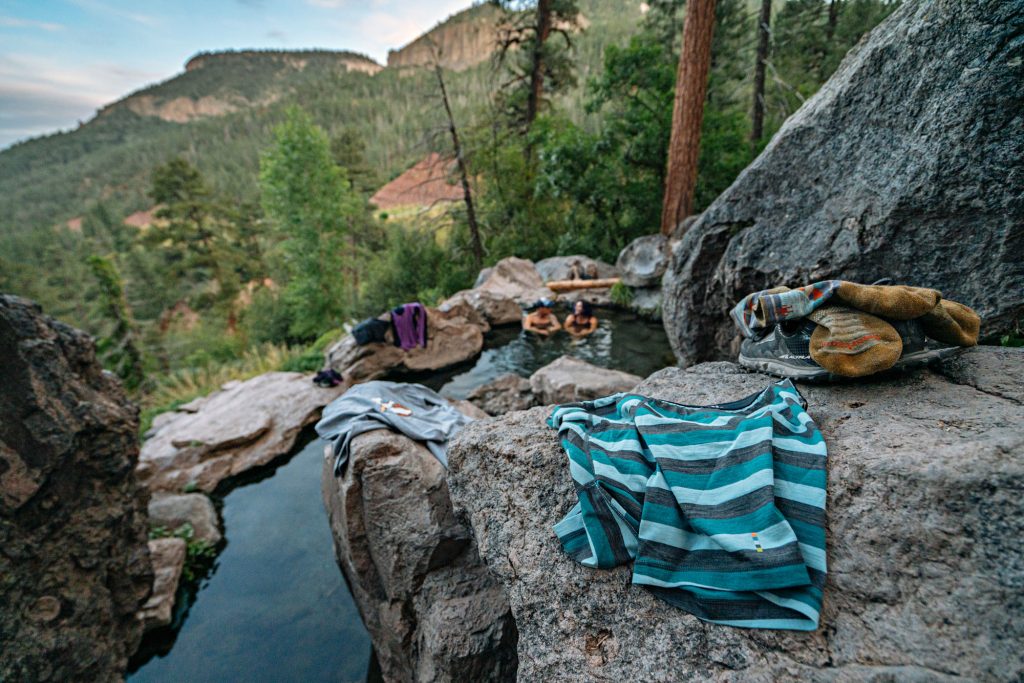Thanks to designs that place function over fashion and the fact that they’re often worn for days at a time—like on backpacking trips—underwear isn’t the sexiest outdoor topic. But it is the foundation of all good layering systems and it affects the performance of every piece put on top of it. It also snuggles up to some of your most delicate parts. If you don’t have any underwear optimal for use outdoors, here are a few good reasons to consider adding some to your kit and what to look for in performance drawers.
Cotton Kills
“Cotton kills” has long been a mantra of outdoor recreators. It soaks up water, takes forever to dry, and doesn’t insulate when wet—that’s how it earned its “deadly” reputation and why it’s generally avoided for outdoor wear.
On the underwear front, there’s an additional problem: it threatens your overall comfort level. Wet cotton underwear leaves your skin feeling damp and increases the chances of chafing and general undercarriage unpleasantness, prompting sayings like “cotton kills your undercarriage” and “cotton kills a good time.” This alone is reason enough to leave it behind on your next outdoor adventure and opt instead for a pair of something made with a quick-drying, wicking, and breathable material.
Outdoor Underwear Fabric
Performance skivvies generally fall into two categories: underwear made from synthetic fabrics (e.g., polyester or nylon) and those made with merino wool. Both synthetic and wool underwear offer a huge upgrade over cotton, and each has its own pros and cons.
Synthetic
Synthetic underwear is readily available and comparatively affordable—you’ll find it everywhere from big box stores to outdoor specialty shops. As a result, it is a popular performance underwear option.
Synthetic fabrics are fast-wicking, quick-drying, and durable, all characteristics prized by outdoor enthusiasts. The main downside is that they tend to hold onto odors, which isn’t great if you’ve been sweating out a hike in hot weather or when you consider exactly what underwear is sitting against.
Wool
Merino wool is a popular alternative to synthetic fabrics, as it’s naturally wicking and odor-resistant—keeping funky smells at bay even after days of wear. Unlike traditional wool, the fine fibers found in merino wool not only ditch the itch but provide a soft fabric that feels great against your skin. The downside of merino wool is that it is often a bit pricier than its synthetic counterparts and while it efficiently wicks sweat from the skin, it holds onto moisture longer than synthetics which can leave you feeling moist (that’s right, we said it) down there. On a positive note, wool retains its insulating properties when wet.

Outdoor Underwear Design
Comfort is an essential characteristic of outdoor underwear. After all, if it isn’t comfortable you might as well go commando. While fabric choice plays a role in keeping you dry and stink-free, a host of other factors contribute to the well-being of your bits when on the trail, track, or water.
Construction
The thoughtfulness with which performance underwear is made plays a substantial role in your happiness with it.
- Flatlock seams lay flat against the skin and are less likely to cause irritation when on the go.
- Seam placement is of paramount importance. It’s a good idea to avoid undies with seams running over—or rubbing on—sensitive places prone to chaffing and discomfort.
- Waistbands are another area of common annoyance, especially when wearing multiple layers. Generally, underwear with thin, unobtrusive waistbands is more comfortable than those with big bulky bands.
- Tags are another area that can rub you raw during a long day on the move—tagless is a nice feature to find in outdoor underwear.
Properly Fitting Outdoor Underwear
From thong to long, there’s no shortage of outdoor underwear styles. In general, it’s recommended to opt for a style you’re comfortable with and prioritize function over form—even if it means donning tighty-whitey type briefs or granny panties. Form-fitting underwear stays in place better (read: fewer wedgies), reduces the odds of undies bunching up, and is less likely to lead to chafing. Looser underwear allows better ventilation, which is good. The ideal pair of outdoor undies strikes a middle ground between loose and tight.
Other Considerations
Who would believe there is so much to know about hiking skivvies? Here are a few more factors to consider when choosing a pair.
- Flies: Some men’s underwear has them, while others don’t. If a fly is a must-have feature for you, make sure the pair you have has one.
- Durability: Outdoor underwear isn’t like that special lingerie that gets worn once a year on Valentine’s Day, it’s made for day-to-day use. Read reviews, check the construction, and buy from a trusted manufacturer—after all, you don’t want a wardrobe malfunction in the middle of a multi-day backpacking trip.
Why You Should Buy Outdoor Underwear
Performance underwear isn’t as splashy as some other outdoor purchases, like a fancy new shell, shoes, or pack. Indeed, they’re typically hidden under a host of other layers. That said, a good pair of outdoor underwear can exponentially increase your enjoyment of the outdoors and just maybe keep you from walking funny a few days after your next big hike.

Tim Peck and Doug Martland
Tim and Doug met long ago at the Eastern Mountain Sports in Canton, Massachusetts. Bonding over a love of slick Quincy Quarry granite, White Mountain sufferfests, and scheming up adventures while folding tee-shirts, today Tim and Doug collaborate to write about their favorite outdoor activities and occasionally get nostalgic about tee-shirt tables.




